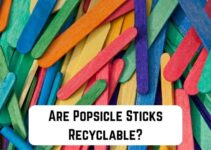Loud noises can cause permanent damage to your hearing. It can also lead to other health issues like increased blood pressure and stress. Earplugs are highly recommended to reduce noise levels and prevent these health issues.
While they are popular amongst consumers because they are cheap, they have contributed to landfills’ overflowing, mainly because they are designed to be used just once. They are also more costly in terms of the long-term consequences of their disposal and environmental implications.
We can find a solution to this problem by recycling. But whether or not foam earplugs can be recycled is subject to question, one we will answer in this article. So, read on to find out more.
Are Foam Earplugs Recyclable?
The undisputable fact is that earplugs protect us from harmful exposure to noise-generating activities such as shooting, industrial processes, etc. The most common type of hearing protection is single-use foam disposable earplugs. They are mainly used because they are affordable, fit easily, offer protection from surrounding noise, and come in various shapes and colors.
Simply put, no, foam earplugs aren’t recyclable. This is why they mostly end up as waste dumped in water bodies or left to overflow in landfills. Foam earplugs resist the recycling method because they make them from the petrochemicals; polyvinyl chloride, or polyurethane, also known as memory foam.
Polyurethane and polyvinyl chloride provide practical insulation and noise cancellation materials. As a result of these properties, they are commonly used in homes to produce insulated windows, doors, walls, and roofs and commercially to manufacture foam earplugs. And although these petrochemicals can’t be recycled, they can be down-cycled and burned as fuel.
Polyurethane and polyvinyl chloride, just like other plastics, are made from crude oil. They are both produced through a cross chemistry process, making them difficult to melt and reform. This reduces the recycling options for foam earplugs, so they can only be shredded. As a result, shredded foam earplugs can therefore be used to make carpets only.
However, new approaches to recycling foam earplugs have begun to come up. One of which includes a two-step process whereby the foam is softened with dibutyltin dilaurate, an oily, colorless liquid that acts as a catalyst. The fluid makes the foam less spongy so that it can be easily expelled.
Next, a specially designed machine with twin-screw extrusions continuously reprocesses the foam while removing the air in it and increasing the consistency of the less spongy foam. The result is a new material that can be used to produce hard plastics and flexible films.
Are Foam Earplugs Toxic?
Foam earplugs are an excellent choice for those seeking to reduce noise, and they are usually not toxic. They don’t contain any harmful materials and, if ingested, will come out of the digestive passage and be expelled normally. However, they can become toxic if caught in the windpipe and may cause breathing problems and lead to injury or death.
They also pose a health hazard to the environment because the material from which they are made-polyvinyl chloride- releases harmful chemicals when they are disposed of in landfills.
Can You Reuse Foam Earplugs?
Most foam earplugs have a short lifespan and are only made for one-time use. They get dirty quickly and get infested with bacteria very easily due to their porous material and the combination of warmth, dirt, and moisture in your ear. This is why they are made disposable.
The good news is that foam earplugs are cheap. And since they are very affordable, you can buy as many as possible as often as you want.
However, if you decide to reuse your earplugs, you would need to give them a good wash before using them. You will also need to take proper care of them by ensuring they are dry and stored properly.
How Do You Clean Reusable Foam Earplugs?
Some of us like to get our money’s worth when purchasing products. So, instead of just disposing of our earplugs after a single-use, we’d use them until they’re too worn out to be used further.
Although this isn’t advisable because these plugs are designed to have a short life span and aren’t hygienic, there are a few ways to clean them to make them suitable for second, third, or fourth use.
To reuse your earplugs, you can wash them in warm water with mild soap severally, removing all earwax and contaminants and then allowing them to air dry. It’s not advisable to use harsh chemicals like alcohol cleaners, solvents, or bleach to clean your earplugs. These could shorten their life span and reduce their effectiveness.
Another way to clean your earplugs is by using hydrogen peroxide. According to audiologists, they should be left to soak in a bowl of hydrogen peroxide mixed with warm water for a few minutes. This makes dirt easier to remove because it helps to loosen up the earwax.
After the soaking is done, you can use your fingers or a soft toothbrush (preferably one you don’t use anymore to avoid being disgusted) to scrub away the debris gently. Once all the dirt is gone, you should rinse the earplugs with cold water and air dry them.
To maintain them, you should store your earplugs in their original boxes or cases to prevent them from being contaminated or damaged. If you can’t find the original case, you must ensure they’re stores somewhere that dirt and grease won’t reach them.
But be sure to take them out sometimes to clean, so bacteria doesn’t breed in them while in their case. Also, ensure they aren’t still wet when putting them in their cases to prevent the same thing.
It would help if you tried to use your earplugs only when necessary to prevent grease and wax from contaminating them easily. Also, ensure your ears are always clean to prevent your plugs from being coated with resin every time you use them.
Despite these methods of cleaning your foam plugs, you should immediately discard them if you notice that they are hard or damaged. Never try to reuse a compromised earplug.
Can Foam Earplugs Damage Your Ears?
Foam earplugs are designed to protect the inner ear. But sometimes, when misused or overused, foam earplugs can cause severe damage to your ears. Some of the harmful impacts of foam earplugs on your ears include:
1. Ear Infections
Prolonged use of foam earplugs can cause bacteria to breed and grow in the moist area of your ears. This leads to ear infections with symptoms ranging from itching, discharge, pain, redness, dizziness, and nausea, among others. If the condition isn’t treated early enough, it could lead to permanent hearing damage.
2. Temporary Hearing Loss
This occurs when earplugs push back ear wax causing it to become impacted, leading to temporary hearing loss. The wax in the ear is supposed to protect the ear structures from dirt and other substances. It usually drains out of the ears little by little, leaving only a small amount for protection.
Prolonged use of foam earplugs prevents the wax from draining out, pushing it further into the ear canal, and causing hearing loss. It can also lead to tinnitus, a ringing effect in the ears. This can be treated using prescribed ear drops or having a doctor remove the excess wax for you.
Also, using the same earplugs repeatedly can cause a build-up of bacteria and infection which can eventually cause permanent hearing damage or loss.
3. Ear Pain
We highly recommend you get an earplug that fits your ear canal. Although foam earplugs usually contract to fit the ears of the wearer, your ears might start to ache if you use earplugs that are bigger than your ear canal. You should get smaller earplugs and not force big ones into your ears in such a case.
4. Other Risks
Other external risks associated with using foam earplugs include the inability to hear in danger or emergencies such as fire outbreaks, alarms, people shouting for help, baby crying, etc.
Can You Wash Memory Foam Earplugs?
You must have them cleaned before use, no matter how often you decide to reuse your foam earplugs. And once they are no more suitable to be used another time, you discard them. But no matter how often you clean them for reuse, you can’t wash away the memory from the earplugs.
Foam earplugs are produced from polyurethane, popularly referred to as memory foam. The name was derived due to its visco-elastic property, which is the ability of the products made from the chemical to slowly bounce back to their original position or shape once pressure is removed from it.
This property allows foam earplugs to be squeezed into the ear but swells back to their standard shape once they’re taken out. This is because added compounds such as Toluene diisocyanate (TDI), methylene diphenyl diisocyanate (MDI), and polyether polyol give the foam its elasticity and viscosity.
Do Foam Earplugs Expire?
Although foam earplugs are made for single-use, they don’t usually have an expiration date. If you’re trying to be economical and environmentally conscious, you can extend their life span by washing them and allowing them to dry correctly.
So, if you’ve had an unused one for a while, there’s no need to worry about an expiration date.
Also, they can last for weeks if they are kept under suitable conditions. This means they must be kept in a dry place under average temperature. When you keep your foam-type earplugs in a hot environment like a metal box for an extended period, it causes them to degrade quickly. And when kept in a cold environment, they would soon become too rigid.
Eventually, your earplugs will deteriorate and become brick hard, no matter how well you wash them or store them safely. They might even begin to hold on to moisture when you wash them, causing them to swell or not re-inflate when you squeeze them. At this point, you should toss them out for a new pair.
Conclusion
Science has confirmed that noise affects the quality of your sleep and is detrimental to your health. But it has also provided a quick fix with earplugs. Comfort, ease of use, lightweight, ability to fit into several ear canals, and noise reduction abilities are essential properties that a suitable earplug should have. And foam earplugs have all.
But beyond these, the fact remains that they are harmful to our environment, and they can get into our waterways and cause harm as much as plastics do. This is because they don’t biodegrade and aren’t recyclable.
Foam earplugs are inexpensive and easy to maintain if you’re not keen on one-off use. But the best solution to help the environment is to reuse your earplugs as many times as possible before discarding them.






